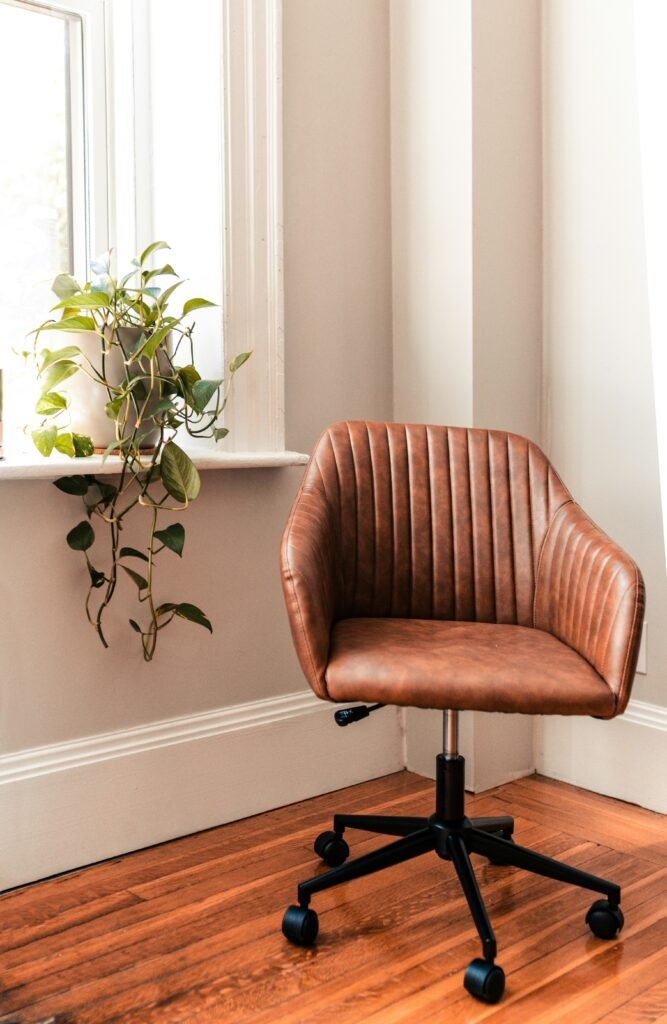Whether you’re an office worker, a gamer, or someone who simply loves lounging in your favorite chair, taking care of your seating is crucial for its longevity. In this article, you will discover a handful of essential chair maintenance tips that will help you keep your chairs in pristine condition. From basic cleaning techniques to preventing wear and tear, these easy-to-follow suggestions will ensure that your beloved chairs will provide you with comfort and support for years to come. So, let’s explore the world of chair maintenance and unlock the secrets to keeping your seating in top shape.

This image is property of images.unsplash.com.
Cleaning
Cleaning your chairs regularly is an essential part of their maintenance to ensure their longevity. By removing dust and debris, you can prevent them from accumulating and causing damage to the upholstery or other parts of the chair. Dust can settle into the crevices and fabric, which not only looks unsightly but can also lead to wear and tear over time. Use a soft brush or vacuum cleaner with a brush attachment to gently remove any dust or debris from the surface.
When it comes to upholstery, vacuuming is a crucial step in keeping it clean. Dust, dirt, and even pet hair can accumulate on upholstered chairs, making them look dull and dirty. Use the upholstery attachment on your vacuum cleaner to gently vacuum the fabric, paying attention to any creases or folds where debris might collect. This simple step can make a significant difference in maintaining the appearance and cleanliness of your chairs.
If you have leather chairs, cleaning them requires a slightly different approach. Start by wiping the surface with a soft, dry cloth to remove any dust or loose dirt. Then, dampen a clean cloth with a mild soap and water solution, and gently wipe down the leather. Avoid using excessive water or harsh cleaners, as they can damage the leather. Finally, dry the leather thoroughly with a soft, dry cloth to prevent any moisture from seeping into the material.
For stubborn stains or spills on upholstered chairs, using an upholstery cleaner can be effective. Before using any cleaning product, always check the manufacturer’s instructions and test it on a small inconspicuous area to ensure compatibility. Follow the product instructions carefully and use a clean cloth or sponge to apply the cleaner to the stained area. Gently blot the stain, avoiding rubbing or scrubbing, as this can spread the stain further or damage the fabric. Once the stain is removed, use a clean, damp cloth to rinse the area, and then blot it dry with a towel.
Inspecting
Regularly inspecting your chairs is another important aspect of maintenance. By checking for loose screws or bolts, you can prevent any further damage or potential accidents. Take a moment to examine the screws and bolts throughout the chair, tightening any that may have come loose over time. If you notice any missing or stripped screws, replace them promptly to ensure the integrity of the chair’s structure.
In addition to the hardware, examining the frame of the chair is crucial. Look for any visible signs of damage or wear, such as cracks or splinters in wooden frames or bent metal parts. These issues should be addressed promptly to prevent further deterioration or potential safety hazards. If you notice any structural problems, consult a professional for repairs to ensure the stability and longevity of your chair.
Inspecting the upholstery is also essential in maintaining your chairs. Look for tears, fraying, or worn areas that may need repair or replacement. Small tears can potentially lead to larger ones if left unattended, so addressing them promptly is crucial. If you have upholstered chairs, it is also important to check for any signs of woodworm, which are small beetles that can cause significant damage to wooden furniture. Look for small holes or sawdust-like residue, and if you suspect woodworm, seek professional treatment to prevent further infestation.

This image is property of images.unsplash.com.
Preventing Damage
Taking preventative measures can go a long way in protecting your chairs from damage. Avoiding excessive weight on the chair is important, as it can strain the structure and lead to breakages or deformities. If the chair has a weight limit, make sure to adhere to it to ensure its longevity. Additionally, keeping pets away from chairs can help prevent scratches, stains, or other forms of damage that can occur from their claws or accidents. Create designated pet-free areas in your home to minimize the risk of damage to your chairs.
Using chair pads or cushions can also provide a level of protection for your chairs. Placing pads or cushions on the seat or backrest can help distribute weight more evenly and reduce wear and tear on the upholstery. They can also act as a barrier against spills or stains, making it easier to clean and maintain the chair. Additionally, using chair pads or cushions can add extra comfort and make the sitting experience more enjoyable.
Protecting your chairs from direct sunlight is important, as prolonged exposure can cause fading or discoloration of the upholstery or wood. If possible, position your chairs away from direct sunlight or use curtains or blinds to block the UV rays. This simple step can significantly extend the lifespan and appearance of your chairs.
Lubricating
Proper lubrication is crucial for chairs with movable parts to ensure smooth operation and prevent unnecessary wear and tear. Applying oil or lubricant to the movable parts, such as hinges or joints, can help reduce friction and keep them in good working condition. Use a suitable lubricant recommended by the chair manufacturer and apply it according to their instructions. Regularly lubricating swivel mechanisms, such as those found in office chairs, can help maintain their functionality and prevent squeaking or sticking. Similarly, using silicone spray on caster wheels can ensure their smooth movement, especially on hard floors.

This image is property of images.unsplash.com.
Repairing
Regardless of regular maintenance efforts, chairs may occasionally require repairs. Fixing loose screws or bolts is a common repair that can easily be done with basic tools. Simply tighten the loose screws or bolts until they are secure, being careful not to overtighten and damage the chair.
Mending upholstery tears is another repair that can be done to maintain the appearance and functionality of your chairs. If the tear is small, using a fabric glue or iron-on patch can effectively mend it. For larger tears, it may be necessary to sew or restitch the fabric. Consult a professional upholsterer if you are not confident in your ability to repair the upholstery yourself.
For chairs with wooden parts, such as frames or armrests, repairing cracks or damage is crucial in preventing further deterioration and potential safety hazards. Depending on the severity of the damage, you may need to fill the cracks with wood putty or glue and clamp them together until dry. For more extensive damage, it may be necessary to replace the damaged parts entirely or seek professional assistance.
Replacing worn-out casters or wheels is another common repair for chairs that have them. Over time, casters can become worn or damaged, affecting the chair’s mobility or stability. Consult the chair manufacturer or a professional to ensure you are selecting the correct replacement casters or wheels for your specific chair model.
Avoiding Moisture
Moisture can cause significant damage to chairs, especially those made of wood or upholstered with fabric. To avoid moisture-related issues, keep your chairs away from water sources, such as windows, doors, or leaky pipes. Moisture can seep into wooden parts, causing warping or rotting, and can also lead to mold or mildew growth on upholstery.
Using coasters for beverages is a simple yet effective way to prevent moisture damage. Condensation or spills from drinks can easily penetrate the surface of the chair, causing stains, water rings, or even warping. Place coasters on any surface where beverages are regularly placed to protect your chairs from accidental spills.
Using moisture-absorbing products, such as dehumidifiers or silica gel packets, can help control the humidity in the surrounding environment and prevent moisture damage to your chairs. These products are especially useful in areas with high humidity levels or where adequate ventilation is limited.
In the event of spills, it is essential to wipe them immediately to prevent moisture from seeping into the fabric or wood. Use a clean, absorbent cloth to blot the spill, avoiding rubbing or spreading it further. If necessary, use a mild soap and water solution to gently clean the affected area, following the appropriate cleaning guidelines for your specific chair material.
Proper Usage
Using chairs correctly not only ensures their longevity but also promotes comfort and safety. Sitting with correct posture can help distribute weight evenly and minimize strain on the chair’s structure. Sit with your back against the backrest, feet flat on the floor, and maintain a neutral spine position. This not only benefits the chair but also promotes good posture and reduces the risk of back or neck pain.
Avoiding excessive rocking or leaning on chairs can help prevent accidents and damage. While some chairs are designed to provide a slight rocking motion, excessive rocking can put strain on the structure and potentially cause it to tip over or break. Similarly, leaning back too far can cause instability or damage to the backrest. Use chairs as intended, avoiding any excessive or precarious movements.
It is essential to remember that chairs are not ladders or stepping stools. Using them to reach high places or as a makeshift ladder can put excessive weight and strain on the structure, leading to breakages or deformities. Use appropriate tools or step stools for reaching high areas to ensure the safety of both you and the chair.
Avoid standing or jumping on chairs at all costs. Chairs are not designed to support the weight or impact of someone standing or jumping on them. Doing so can cause significant damage to the chair, potentially leading to a complete collapse or injury. Use chairs exclusively for their intended purpose: sitting.
Storing
Properly storing your chairs when not in use is essential for their long-term maintenance and protection. If necessary, disassemble the chairs according to the manufacturer’s instructions before storing them. This helps reduce the risk of damage during transportation or long periods of storage.
Covering or wrapping chairs with appropriate materials, such as fabric covers or plastic wrap, can provide an extra layer of protection against dust, dirt, or accidental damage. Ensure that the covers are secure and snugly fitted to prevent any air or moisture from seeping in.
When it comes to storing chairs, it is essential to choose a dry and climate-controlled area. Moisture can cause mildew, mold, or wood rot, while extreme temperatures can cause warping or cracking. Avoid storing chairs in basements, garages, or outdoor areas where the risk of moisture or temperature fluctuations is high. Instead, opt for an interior space where the humidity and temperature can be controlled.
Avoid stacking heavy items or placing excessive weight on top of stored chairs. This can cause unnecessary strain or deformities to the chairs, compromising their structure and stability. Store chairs separately or use appropriate supports to distribute the weight evenly, ensuring the chairs remain in good condition.
Avoiding Harsh Chemicals
When it comes to cleaning or maintaining your chairs, it is important to use gentle products that are safe for the specific materials. Avoid using bleach or abrasive cleaners, as they can cause discoloration, fading, or even damage to the upholstery or other parts of the chair. Instead, opt for mild soap and water solutions, or specifically formulated cleaners recommended by the manufacturer.
Always check product labels for compatibility before using any cleaning or maintenance products on your chairs. Different materials may have specific care instructions or limitations when it comes to cleaners or treatments. Checking the labels ensures that you are using products that are safe for your specific chair materials, reducing the risk of damage or unwanted effects.
Before using any new cleaning or maintenance product, it is recommended to test it on a small, inconspicuous area of the chair first. This allows you to observe the product’s effect on the material without risking any visible or irreversible damage. If there are no adverse reactions or discoloration, you can proceed with using the product on the rest of the chair.
Professional Maintenance
Sometimes, professional assistance is necessary to properly maintain or repair your chairs. If you are unsure about any repairs or maintenance tasks, or if you lack the tools or expertise to do so, it is always advisable to consult a professional. They can assess the condition of your chairs, provide expert advice, and carry out any necessary repairs or maintenance to ensure their longevity.
Upholstery cleaning services are another professional option to consider for deep cleaning your chairs. Professional cleaners have the expertise and equipment to effectively remove dirt, stains, and odors from upholstery, leaving your chairs looking fresh and rejuvenated. Regular professional cleaning can help extend the lifespan of your chairs while maintaining their aesthetic appeal.
Seeking professional advice is particularly important when dealing with chairs made from specific materials or exhibiting unique characteristics. Different materials, such as leather or antique fabrics, may require specialized care or treatment. Consulting professionals who specialize in these materials can ensure that your chairs receive the appropriate maintenance and care, prolonging their lifespan and preserving their value.
To ensure the overall health and performance of your chairs, it is recommended to schedule annual inspections with a professional. These inspections can help identify any potential issues or maintenance needs that might have gone unnoticed. By addressing them early on, you can prevent further damage and ensure the continued longevity and functionality of your chairs.
Regular maintenance and proper care are vital for the longevity of your chairs. By following these essential chair maintenance tips, you can keep your chairs looking great, functioning properly, and provide comfortable seating for years to come. With a little time and effort, you can enjoy your chairs for extended periods and save yourself from the hassle of premature replacements or costly repairs.
